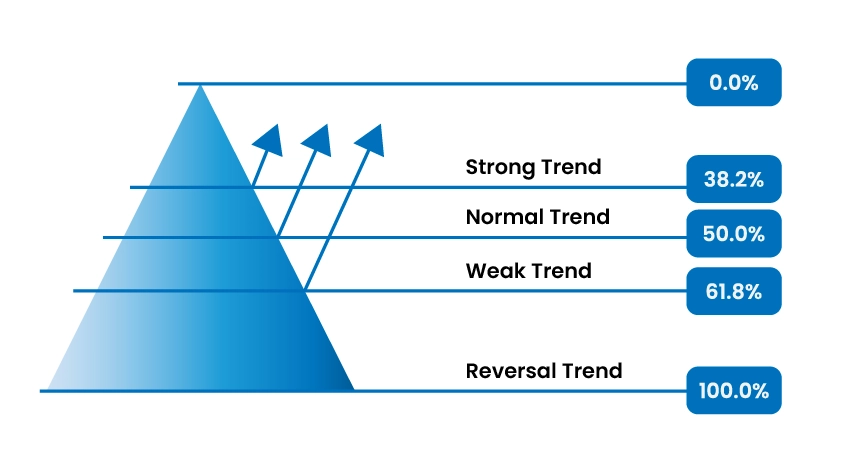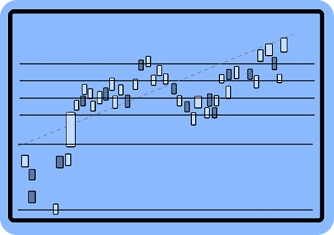

Fibonacci Trading Strategy: How It Works and Why It Matters
The Fibonacci trading strategy is one of the most reliable tools in a trader's arsenal. It offers precise insights into potential market movements. Based on the Fibonacci sequence, this strategy identifies key retracement levels that often act as significant support and resistance zones. Integrating these levels into your trading plan can improve timing, optimize risk management, and enhance profitability. This comprehensive guide explores the core principles of Fibonacci retracement levels, explains their effectiveness, and outlines actionable strategies for successfully applying them in trading.
Understanding Fibonacci Retracement Levels

Fibonacci retracement levels are mathematical calculations derived from the Fibonacci sequence. These levels help traders pinpoint where price reversals or continuations are likely.

23.6% – Indicates shallow retracements in strong trends.
38.2% and 50.0% – Highlight moderate retracement areas, often used for entry points.
61.8% (Golden Ratio) – The most critical level, signifying strong support or resistance.
100% – Represents a full retracement to the original price point.
These levels are visually represented on a price chart using a Fibonacci tool, which helps traders easily identify zones of interest.
Why Fibonacci Works in Trading
Fibonacci levels work effectively in trading for several reasons:
Psychological Impact: Many traders observe these levels, making them self-fulfilling.
Natural Patterns: Markets often exhibit price behavior aligned with the Fibonacci sequence.
Support and Resistance Clarity: Provides clear levels for potential price reactions.
Versatility: Works across various market conditions and timeframes.
How to Use Fibonacci in Trading
Currency Pair: EUR/USD
Timeframe: 1-hour chart
Step-by-Step Implementation:
Step 1: Identify the Trend
You observe that EUR/USD has recently been rising, forming higher highs and higher lows consistently. Confirming this visually and by using a 50-period moving average, you see the price is clearly above the moving average line, indicating an uptrend.
Step 2: Apply the Fibonacci Tool
Since you have identified an uptrend, select the Fibonacci retracement tool from your trading platform. Draw it from the most recent clear swing low (e.g., 1.0900) up to the latest swing high (e.g., 1.1100).
Swing Low: 1.0900
Swing High: 1.1100
Step 3: Monitor Retracement Levels
The Fibonacci retracement levels automatically appear at 38.2%, 50.0%, and 61.8%:
38.2% level: around 1.1024
50.0% level: around 1.1000
61.8% level: around 1.0976
As you watch, the EUR/USD price gradually retraces and approaches the 61.8% level (1.0976), which historically represents a strong support and potential reversal area.
Step 4: Confirm with Other Indicators
At the 61.8% Fibonacci retracement (1.0976), you notice:
The RSI (Relative Strength Index) dips below 30, signaling an oversold market.
A bullish candlestick formation emerges, specifically a clear bullish engulfing pattern, providing further confirmation that buyers are returning to the market.
With these signals aligning, you have a strong indication of a potential price reversal from this Fibonacci level. As a result, you enter a long (buy) position near 1.0976, placing your stop-loss slightly below the retracement level (e.g., at 1.0950), targeting a return toward the previous swing high at 1.1100 or higher.
Key Fibonacci Strategies
1. Reversal Trade (Using Fibonacci Retracement)
Objective:
Identify potential market turning points where price reverses direction after retracing to key Fibonacci levels.
Step-by-Step Implementation:
Setup:
Look for price retracements in a trending market. Focus specifically on the 38.2% or 61.8% Fibonacci retracement levels, as these levels frequently serve as strong support or resistance, prompting reversals.Entry Criteria:
Wait for clear reversal signals such as:Candlestick patterns: Pin bars, bullish/bearish engulfing candles, hammer, or shooting star.
Indicator Confirmation: Oversold or overbought readings (RSI below 30 or above 70).
For example, if the price retraces to the 61.8% level in an uptrend, watch for bullish engulfing candles or a pin bar formation at this level to signal a long entry.
Stop-Loss Placement:
Place your stop-loss just below the next lower Fibonacci level (for longs) or just above the next higher Fibonacci level (for shorts). This provides enough breathing room for market volatility while maintaining controlled risk.Take-Profit Targets:
Target the previous swing high (in an uptrend) or swing low (in a downtrend). Alternatively, extend your take-profit to the next Fibonacci extension (e.g., 127.2% or 161.8%) to maximize profit potential.
Practical Tip:
Always verify reversals with additional technical confirmations, like RSI, Stochastic, or MACD, to avoid false signals.
2. Breakout Trade (Using Fibonacci Levels)
Objective:
Capture significant market movements after periods of consolidation near key Fibonacci levels.
Step-by-Step Implementation:
Setup:
Look for price consolidation or ranging behavior near an important Fibonacci retracement level. The longer the consolidation, the stronger the breakout potential.Entry Criteria:
Wait for a decisive breakout candle that closes clearly above or below the identified Fibonacci level.
Additional confirmation: A spike in trading volume or momentum indicators like MACD can reinforce the validity of the breakout.Stop-Loss Placement:
Place your stop-loss safely within the recent consolidation zone. For example, if the price breaks above the Fibonacci level, place your stop-loss slightly below the lower boundary of the consolidation.Take-Profit Targets:
Aim for Fibonacci extension levels such as the 127.2% or 161.8% extensions, offering clear, measurable profit targets.
Practical Tip:
Beware of fake breakouts (false moves). Confirm breakouts with increased volume and momentum indicators before entering positions.
3. Fibonacci Extensions for Trend Trading
Objective:
Use Fibonacci extension levels to set realistic and profitable price targets during clear trending conditions.
Step-by-Step Implementation:
Setup:
First, confirm the presence of a strong trend by examining price action, higher highs/higher lows for an uptrend or lower highs/lower lows for a downtrend.Drawing Fibonacci Extensions:
Identify the recent significant swing low and swing high points on your chart. Next, draw the Fibonacci extension tool from the swing low to swing high, then back down to the retracement low (in an uptrend), or vice versa in a downtrend.Identifying Targets:
Monitor extension levels like 127.2%, 138.2%, and especially 161.8%, as prices frequently react strongly at these levels. These serve as effective profit-taking targets or areas to scale out of positions.Stop-Loss Placement:
Set a logical stop-loss below recent swing lows (for longs) or above recent swing highs (for shorts) to maintain appropriate risk-to-reward ratios.Managing the Trade:
As the price approaches Fibonacci extensions, consider trailing your stop-loss to lock in profits progressively or partially closing positions at each target level.
Practical Tip:
Combine Fibonacci extensions with trend-following indicators (e.g., moving averages or ADX) to confirm the strength of the prevailing trend, increasing confidence in your price targets.
Advantages of Fibonacci Trading
Ease of Use: Compatible with most charting platforms.
Wide Applicability: Works across commodities, and crypto markets.
Risk Management: Offers precise levels for stop-loss and take-profit.
Enhances Precision: Identifies high-probability trading opportunities.
Disadvantages and Pitfalls
Subjectivity: Swing point selection can vary among traders.
Lagging Nature: Based on historical data, not predictive.
False Signals: Requires confirmation from additional indicators.
Tips for Success with Fibonacci Trading
Multi-Timeframe Analysis: Use higher timeframes for more muscular confluence zones.
Combine Tools: Pair Fibonacci with technical indicators like RSI or MACD.
Backtest Thoroughly: Test strategies on historical data before applying live.
Risk Management: Always use stop-loss orders and adhere to position-sizing rules.
The Fibonacci trading strategy is essential for traders seeking precision and structure in their trading plans. By understanding retracement levels, integrating them with other technical tools, and adhering to disciplined risk management, traders can navigate the market with greater confidence and success.
Start trading smarter with Fibonacci today! Open your TMGM trading account to explore markets, access professional charting tools, and refine your strategies in a risk-free environment.
Negocie de Forma Mais Inteligente Hoje






Real
Conta
Instantaneamente



